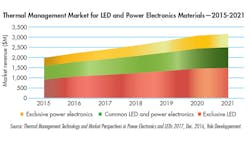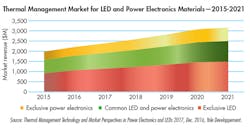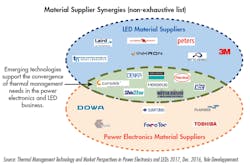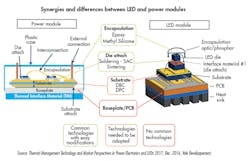LEDs and Power Electronic Innovations Converge to Handle Module-Level Thermal Management
In 2015, all economic indicators pointed to continued market growth for power electronics and LEDs, especially with IGBT modules boosted by EV/HEV industry and general lighting applications, a killer application for LEDs since 2012. To support this growth and answer the thermal management needs in power electronics and LED, many innovative technologies are emerging.
According to Yole Développement (Yole), one of the most impressive technical developments is the convergence of thermal management for both sectors, particularly the materials used for thermal management. The thermal management convergence is driven by the applications, according to the most recent report from Yole, which proposes an overview of the market trends and technology evolution including 2015-2021 market figures (Fig. 1), technology status, and technical roadmap analysis and more.
“Power electronics and LEDs are different industries that today face similar challenges,” said Dr. Pierric Gueguen, business unit manager at Yole, in a press release about the report. He adds, “Needs for green energy with lower CO2 emissions have led these industries to develop more efficient and smaller solutions.” At the device level, cost pressure and the need for better performance is pushing designers toward smaller and thinner chips, also leading to increased power density. Such power density targets in both power electronics and LEDs bring a convergence of thermal management requirements, supporting the development of new materials.
Among materials used for thermal management, Yole specifically investigated the market and technology evolution of die-attach, substrates, baseplates/PCBs, and encapsulants. Overall, the market for these materials was worth US$1.98 billion in 2015 and will grow to US$3.16 billion by 2021 at a CAGR of 6%.
“Their value proposition has the potential to bring business to their suppliers and key differentiating factors to device manufacturers,” says Pierrick Boulay, Technology & Market Analyst at Yole. Figure 2 shows the material supplier synergies and Fig. 3 presents the synergies and differences between LED and power modules.
“Power electronic modules represent a healthy market, worth about US$2.9 billion in 2015 and set to reach US$4.5 billion in 2021, growing at 9% CAGR,” notes Gueguen. In parallel, the LED packaging market reached US$15 billion in 2015, after years of strong growth led by LED TV and general lighting. However, price pressure will moderate growth in coming years, with a 3.4% CAGR leading to a market worth US$18.5 billion in 2021.
Power electronics and LEDs need the right materials to handle thermal management challenges. As those applications are driven by similar technical requirements, one technical solution can be adopted and developed for one industry before being used by another industry.
“The 30% of the overall thermal management material market that is common to both LED and power electronics represents US$660 million in 2015,” says Boulay.
A detailed description of the thermal management report as well as other LED & Power Electronics reports from Yole are available on i-micronews.com.




